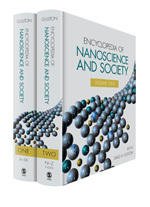Aug 5 2010
Produced by volcanic explosions, nanoparticles – about a thousand times smaller than a fly’s eye – have always been part of the earth’s atmosphere. Used, if not understood, by artisans for centuries, nanomaterials have been part of pottery glazes, metallurgy and the glass work of cathedrals. Produced by diesel exhaust, they have been a human-generated pollutant since before the term nanotechnology was coined. In the modern age, the possibilities for technological achievements at the nanoscale have been the staples of scientific and literary visionaries for decades.
Now, nanoscience has garnered billions of dollars of funding. It has been hailed by promoters as ushering in the “next industrial revolution” and dismissed by skeptics as nothing more than “hype.” But, for such a richly anticipated field, it has already made its way into products all around us – from odor-eating socks to cosmetics, from medications to toys – without much fanfare. At the same time, popular media entertain us with visions of nanotechnology as cornucopia or Armageddon. Somewhere in between are social scientists, ethicists and others reflecting on our understanding of the broad implications of nanotechnology, gauging its promises and risks, assessing the impacts of policy decisions, and communicating the meaning of nanoscience research – in short, observing, contemplating and measuring nanoscience as a social and human endeavor in its origins, practices and consequences.
 The two-volume Encyclopedia of Nanoscience and Society, edited by ASU professor David H. Guston, is accessible and jargon-free.
The two-volume Encyclopedia of Nanoscience and Society, edited by ASU professor David H. Guston, is accessible and jargon-free.
The newly-released two-volume Encyclopedia of Nanoscience and Society is the result. Edited by David H. Guston, director of ASU’s Center for Nanotechnology in Society and professor of political science, this resource isn’t designed for the scientist or engineer, but rather for the rest of us who have plenty of questions about nanotechnology – and what it means for our lives – but are afraid to ask.
We have very little understanding about the occupational safety and health issues involved in either laboratory nanoscience or industrial production of nanomaterials. We have perhaps less understanding about the fate of nano-silver particles – used in myriad consumer products for their antimicrobial properties – as they move from these products into our water and our bodies. We have still less understanding about the ethical, legal and social consequences of even some of the more modest attempts to use nanotechnologies for medical therapies like targeted cancer drugs, and enhancements like neural implants. And we have, perhaps, the least understanding of what will happen technically, environmentally and culturally if and when nanoscience and nanotechnologies converge with synthetic biology, with robotics and with neurotechnologies.
“It is possible that both perspectives – next industrial revolution or just hype – are correct,” said Guston. “Nanoscience and nanotechnology could at some time emerge as the engines of one of the most spectacular transformations of human societies, but it also could be that we started down this path led more by our hopes and fears than by reason, more by a sense of adventure than a sense of responsibility. It is challenges like these that make an encyclopedia of nanoscience and society a necessity.”
The Encyclopedia of Nanoscience and Society provides an accessible and jargon-free guide to what these understandings and challenges are all about.
Published by SAGE Publications, Inc., the Encyclopedia of Nanoscience and Society contains approximately 425 signed entries by contributors from a variety of disciplines – sociology and psychology, economics and business, science and engineering, computing and information technology, philosophy, ethics, public policy, and more. They bring varied perspectives to the questions of nanotechnology in society in such general topic areas as: ethics and values; social and environmental issues; law, policy, regulation and governance around the globe; art, design and materials; agriculture and food safety; health, safety, and medical ethics; commercial and economic issues; educational and training issues; computing and information technology; history, philosophy and the human condition; national security and civil liberties; military uses and issues; converging technologies; risk assessment; and technology “haves” and “have-nots.” It also includes helpful aids such as a chronology, a resource guide and a glossary.
Among the contributors to the Encyclopedia of Nanoscience and Society are 26 scholars from Arizona State University and beyond who are affiliated with the Center for Nanotechnology in Society (CNS-ASU), which is funded by the National Science Foundation:
Braden Allenby, ASU
Javiera Barandiaran, University of California, Berkeley
Daniel Barben, RWTH Aachen University
Troy Benn, ASU
Shannon Conley, ASU
Elizabeth A. Corley, ASU
Susan Cozzens, Georgia Tech
Erik Fisher, ASU
Patrick Hamlett, North Carolina State University
Matthew Harsh, ASU
Sean Hays, ASU
Shirley Ho, University of Wisconsin
Daniel Lee Kleinman, University of Wisconsin
Gary Marchant, ASU
Richard Milford, ASU
Mark Philbrick, University of California, Berkeley
Alan L. Porter, Georgia Tech
Juan D. Rogers, Georgia Tech
Cynthia Selin, ASU
Dietram Scheufele, University of Wisconsin
Philip Shapira, Georgia Tech
Catherine Slade, ASU and University of Georgia
Li Tang, Georgia Tech
Jue Wang, Florida International University
Jameson Wetmore, ASU
Gregor Wolbring, University of Calgary